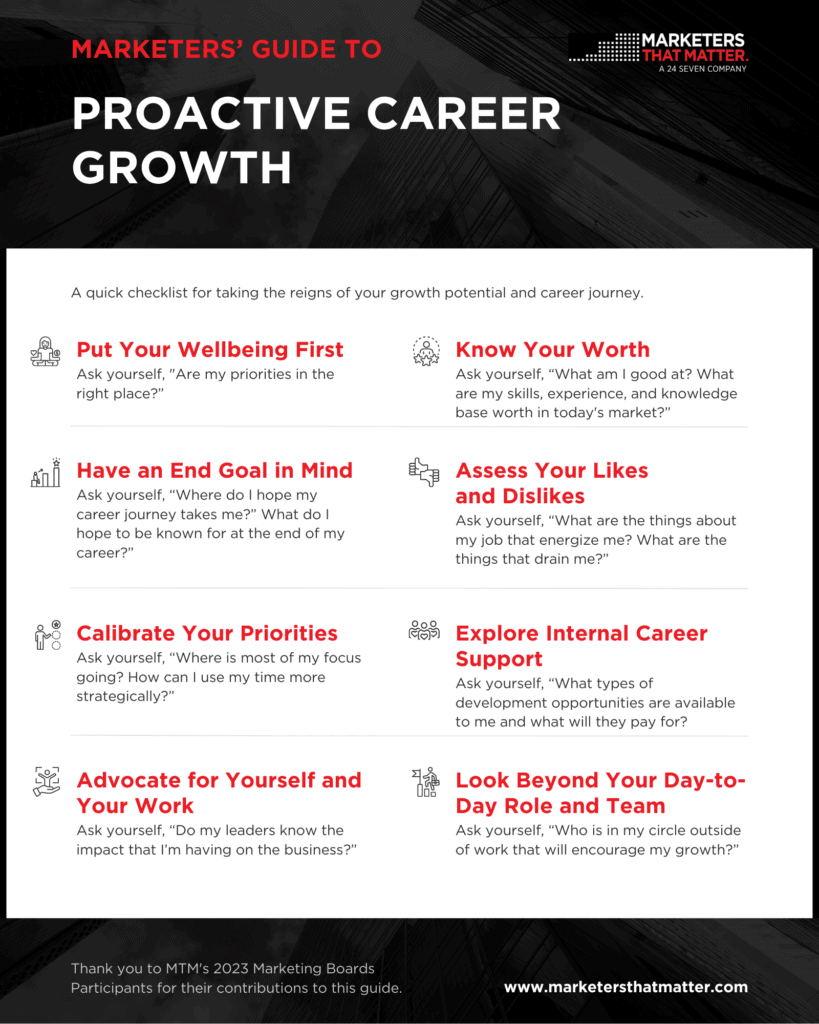If you were to answer honestly, who would you say is driving your career? Do you leave it to chance or are you taking the lead to fuel your own growth?
Playing a proactive role in your growth tends to take a backseat for mid-level leaders––mainly due to the amount of time needed to dedicate to it. The two biggest barriers––identified by a group of director-level brand leaders as part of our 2023 Marketing Boards Program––are that most leaders spend the majority of their time developing the team rather than themselves, and second, there’s often no clear path forward.
So, how do you take action and create your own career instead of waiting for your organization (or fate) to make the path for you? In this guide, you’ll find a living, breathing, non-linear checklist to serve as an ongoing resource to help you be more proactive in your own career development.
And if you don’t have clarity on your long-term career goals just yet (i.e. you despise the “where do you see yourself in five years” question), you can use this checklist to set things in focus, establish a general direction and identify your best next step even without knowing what the end goal may be.
Tip: Click the image to download your checklist and pin it up somewhere where you can regularly reference:

Put Your Wellbeing First (Mental, Emotional, Spiritual, and Physical)
💭 Ask yourself, “Are my priorities in the right place?”
- Remind yourself that your impact as a leader is only as strong as your commitment to your well-being.
- Jot down the areas of your life that matter most to you and the things that bring you deep joy. Think about how much time you allow for those joy-bringers throughout your week and how you can build in more time for them.
- Set firm boundaries to protect your personal time, and don’t be ashamed to be vocal about them. Schedule blocks on your calendar and consider them non-negotiable if needed.
- Never let work supersede your basic needs, personal appointments, or important family matters.
- Take note of the ‘temperature’ of your work environment. It could be affecting your well-being more than you know.
Advice from an MTM Visionary: “Burn-out is super real… It’s not about work-life balance but more like work-life rhythm. There’s this ebb and flow of life and work that you have to get into a rhythm with. And we’ve been empowered to create our own schedules to make sure we’re getting our priorities done but that we’re also taking care of our families and taking care of ourselves, both mentally and physically. So I’ve been using my calendar to help try to keep that rhythm.”
Jabari Hearn, Managing Partner, AKQA
Start with the End-game in Mind
💭 Ask yourself, “Where do I hope my career journey takes me? What do I hope to be known for at the end of my career?”
- If you know you want to be a CMO one day or a founder of your own company, start there and work backwards. Identify the stepping stones and consider how your current roles and responsibilities are lining up (or not lining up) to get you there. This will show you in what areas you may need to flex up or down.
- Be Specific: Identify 3-5 skills you need to sharpen to attain that end goal, and then identify industry leaders who demonstrate those skills. These are your future “superpowers” you want to develop. Research those leaders, and listen to their advice (shameless plug for MTM’s Visionaries podcast) on how they got to where they are.
- Set aside time to daydream a little. This helps you envision your future without the pressure of having to have it all figured out. It’s less about the where and how and more about imagining what you want to be known for and the impact you want to have on others and the world around you.
Know Your Worth
💭 Ask yourself, “What am I good at? What are my skills, experience, and knowledge base worth?”
- Take stock of your strengths. What are your top 3 soft skills? Top 3 hard skills? Then think about how valuable those skills are in getting you to your next step. You may need to assess whether those skills are being showcased enough through your personal brand as well as social and professional presence.
- Keep a steady pulse on in-demand roles, skill sets, and salary ranges to help you maintain a competitive edge in your career planning.
- Proactively develop relationships with recruiters in your target areas of interest and firms representing the brands and industries you’re interested in. (Don’t wait until you’re seeking a new role to get on their radar!)
- Find the right negotiation tools for a pay increase and promotion.
- Not sure what makes you stand apart? Ask people you trust (mentors, colleagues, friends) for honest input. Their outside-in perspective will be invaluable in helping you see what others see in you.
Assess What You Like and What You Don’t Like
💭 Ask yourself, “What are the things about my job that energize me? What are the things that drain me?”
- Identify the top 3 things you enjoy about your role and top 3 dislikes. This will help you start forming criteria for evaluating future opportunities.
- Consider your hobbies or volunteer work. What aspects of these activities spark joy?
- Are there tasks/responsibilities from previous roles that you particularly enjoyed and aligned with your strengths?
Advice from an MTM Visionary: “Purpose didn’t just happen for me. I had to do a lot of soul-searching and see what I was naturally gravitating towards…when you are clear and vocal about your purpose, you will attract those people…When the people you work with have shared values and purpose, that’s what makes the work fun, and when you feel like you’re living out what you’re meant to do.”
Kalen Thornton, VP Sports, Entertainment & Gaming at PepsiCo
Calibrate Your Priorities and Focus
💭 Ask yourself, “Where is most of my focus going? How can I use my time more strategically?”
- Regularly evaluate your work priorities, projects, and workload. Are you working your way into a promotion or perhaps a new role? Or, if you were honest, are you stagnant? A good thing to ask yourself is: “In this role, am I learning or earning?” It should be one or both, but if it’s neither, that should be a wake-up call.
- Lead yourself (and even your team) through a Start/Stop/Continue exercise in order to recalibrate where you’re spending your time. It’s ok to put your needs at the forefront and adjust priorities to ensure they’re serving the needs of your broader career plans, not just your day-to-day role.
- Think about how you can stretch yourself with opportunities that ladder up to your longer-term aspirations. Example: If you want to move to a GM-type of role in the future, see how you can get more involved in budget and revenue conversations.
- Take on stretch projects to increase visibility (cross-functionally and within the organization) and sharpen your skills in an area that specifically connects to where you want to grow.
Advice from an MTM Visionary: “There’s a difference between personal purpose and work purpose, and it’s important to know that your purpose can evolve. For me, I constantly check in with what makes me feel happy, and I am equally as clear about the things that don’t bring me joy. Then, I make conscious choices to step away from those things that aren’t serving me, my team, or my work.”
Nikki Neuburger, CBO, Lululemon
Explore Internal Career Support
💭 Ask yourself, “What resources are available to me through my organization?”
- Don’t wait until your annual review to have conversations with your leader and or sponsor about career pathing. Use 1:1s and other regular check-ins to consistently bring it up.
- Knowing what’s currently available to support your career growth is only half the battle. You should take it a step further and proactively ask for and advocate for specific things that will help your career advancement. You never know until you ask, and more often than not, companies are willing to invest time and funds to support professional development.
“Have regular conversations with your leader on your next steps and what it will take to get there. This way you and the organization are aligned on what it takes to get promoted before those discussions ever begin.”
Justin Brown, Director, Brand Marketing, EA Sports
Look Beyond Your Function and Day-to-Day team
💭 Ask yourself, “Who is in my circle outside of work that will encourage my growth?”
- Build a network of advocates (mentors, personal relationships, personal board of directors) with leaders outside of your function.
- Focus on your personal brand. What sets you apart? What’s your unique voice and vantage point? Do you have a specialty or strong passion for specific topics? Lean into this.
- Network with people (on social media or in person) who share similar perspectives, passions, and interests.
- Try branching out. Go to an event, retreat, or networking opportunity to connect with people you’ve never met before. You may be shocked by the level of connection and relationships that develop when you make yourself vulnerable and try something new.
“Looking for advocates or a network outside of your function can help provide unbiased advice, give you insight into their perspective and even unlock a career path you hadn’t considered. Reaching out to build a connection can feel awkward… My approach to quieting my inner critic is to remember that they are people and have been in my position at some point.”
Annie Nguyen, Director of Loyalty Promotions, Sephora
Advocate for Yourself and Your Work
💭 Ask yourself, “Do my leaders know the impact that I’m having on the business?”
- Actively socialize your work and your impact. How are you socializing your work and your impact to leadership? To counterparts? To your network? This is good for you and your team as it raises visibility of you and the work and will get you one step ahead for quarterly/annual reviews.
- Create your own personal objectives and key results or highlight key wins every quarter or semi-annually. Share with your manager or leadership.
- Balance humility with self-advocacy. Don’t shy away from talking about your impact and results but do it in a way that shows your impact on the business.
Advice from an MTM Visionary: “I used to get frustrated by being unable to sell ideas when I was younger because I was packaging them in a way that made sense to me and the culture at large but not to those suits in the boardroom. What I’d say to young marketers is: figure out how to speak the language of growth in your company and package it accordingly.”
Daniel Cherry III, SVP & GM at adidas
Thank you to the following MTM Marketing Board participants who contributed to this guide on Catalyzing Growth Potential:
Annie Nguyen, Director of Loyalty Promotions, Sephora
Christina Cartal, Director Content Strategy, NerdWallet
Jonathan Kriner, Sr. Manager, Ad Growth Marketing, Roku
Justin Brown, Director, Brand Marketing, EA Sports
Vanessa Granat, Senior Director, Sales Enablement, First Republic
Vivian Zeldis, Director, Retention Mobile Messaging & Retention Analytics, Sephora


